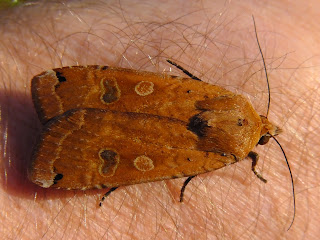Update: Thanks to MoreMoth at iSpot who has identified this as the May Highflyer. It's no wonder I couldn't identify it because this individual is so much more dramatic than the illustrations in the literature that I have. The streaks at the corners of the wings are helpful id features.
This Turnip Moth looks pretty harmless, but its one of a family whose larvae - called cutworms - can be a serious pest of cereals and other crops.
Vine's Rustic...I'll keep uploading photos of this because I want to get this species 'into my head'!
I had my first Isle of Wight Caddis Fly in the trap this morning, too!
So, more good news for the back garden.....the bad news was apparent in the front garden:
Carole's flower pots, with their nice damp soil, made a very attractive dinner setting for Brock the Badger last night! Carole was not pleased!!




















































